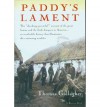Currently reading
Paddy's Lament, Ireland 1846-1847: Prelude to Hatred
Pivot: The Only Move That Matters Is Your Next One
When in French: Love in a Second Language
Beyond the Job Description: How Managers and Employees Can Navigate the True Demands of the Job
Vision and Art: The Biology of Seeing
Achieving Your Potential As A Photographer: A Creative Companion and Workbook
Reclaiming Conversation: The Power of Talk in a Digital Age
Picture Perfect Practice: A Self-Training Guide to Mastering the Challenges of Taking World-Class Photographs (Voices That Matter)
Man's Search for Meaning
Terms of Service: Social Media and the Price of Constant Connection
The Pattern in the Carpet: A Personal History with Jigsaws
 What I liked: the memories and relationship with her aunt, who she associates with jigsaws. What I didn't like: long digressions, lack of focus, a bit of rambling. I could get into it as a loose meditation, but I don't think a writer with a lesser reputation would have been allowed to ramble so. "auntie Phyl took us from Bryn to see Lincoln cathedral. We liked the Lincoln imp in the angel choir. She had a gift for capturing a child's attention by pointing out such things. The rose windows were too big for me, too bright, too high, too far away and I had no interest in their iconography, authentic or jumbled, but I could see the imp and the angels. We liked to talk about such memories, "Do you remember when we went to see the Lincoln imp?" "Do you remember the horseshoes at Scarrington?" So we built up our pictures of the past." p.161"I recently came across a book titled The Eloquence of Appropriation: A Prolegomena to an Understanding of Spolia in Early Christian Rome, which describes in some detail the process of recycling that is so poignantly visible in Rome . . ..Stones may be reborn. There's a phrase for this, as the book on antique spolia told me. Redivia saxa. And if stones, why not we? I find even the title of this book about spolia oddly moving. It describes a process of melding, joining and reassembling that affirms not entropy but continuity and survival and the grand aesethic of time." p.167"As children, we were issued the strictest of warning about this major road, for it was a fearsome force. We must never, ever try to cross it alone. We must never even walk on its grass verge. We must never go to the village shop opposite without an accompanying adult. Crossing to the shop was like crossing a perilous torrent. I can't remember now whether there were proper crossings in the village where the lorries had to stop for pedestrians; I suppose there must have been. I remember well Joyce's crossing, which she policed for the school in her smart yellow fluorescent uniform, but there must have been others. We were far too docile to try anything risky, but I think we were impressed by the danger on the doorstep. It made life more exciting." p/35
What I liked: the memories and relationship with her aunt, who she associates with jigsaws. What I didn't like: long digressions, lack of focus, a bit of rambling. I could get into it as a loose meditation, but I don't think a writer with a lesser reputation would have been allowed to ramble so. "auntie Phyl took us from Bryn to see Lincoln cathedral. We liked the Lincoln imp in the angel choir. She had a gift for capturing a child's attention by pointing out such things. The rose windows were too big for me, too bright, too high, too far away and I had no interest in their iconography, authentic or jumbled, but I could see the imp and the angels. We liked to talk about such memories, "Do you remember when we went to see the Lincoln imp?" "Do you remember the horseshoes at Scarrington?" So we built up our pictures of the past." p.161"I recently came across a book titled The Eloquence of Appropriation: A Prolegomena to an Understanding of Spolia in Early Christian Rome, which describes in some detail the process of recycling that is so poignantly visible in Rome . . ..Stones may be reborn. There's a phrase for this, as the book on antique spolia told me. Redivia saxa. And if stones, why not we? I find even the title of this book about spolia oddly moving. It describes a process of melding, joining and reassembling that affirms not entropy but continuity and survival and the grand aesethic of time." p.167"As children, we were issued the strictest of warning about this major road, for it was a fearsome force. We must never, ever try to cross it alone. We must never even walk on its grass verge. We must never go to the village shop opposite without an accompanying adult. Crossing to the shop was like crossing a perilous torrent. I can't remember now whether there were proper crossings in the village where the lorries had to stop for pedestrians; I suppose there must have been. I remember well Joyce's crossing, which she policed for the school in her smart yellow fluorescent uniform, but there must have been others. We were far too docile to try anything risky, but I think we were impressed by the danger on the doorstep. It made life more exciting." p/35













